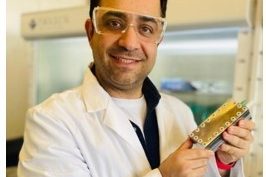The lithium-ion (Li-ion) battery (LIB) is the predominant commercial rechargeable battery; however, the costs are impacted by the availability of critical minerals such as lithium, cobalt and nickel, while there are increasing safety concerns from overheating (fires) and damage at high voltages. To address these shortcomings, the NEMCAT group and Vecor have embarked on the development of cost-effective, efficient rechargeable batteries with alternative materials to expensive and strategically sensitive lithium. The substantial funding by Vecor to establish dedicated research laboratories at UNSW is complemented by major product development efforts led by Dr. Mofarah, A/Prof. Koshy, and Prof. Sorrell with patented technologies developed by the UNSW team opening up globally competitive commercial opportunities.
Vecor CEO Mark Ramsey stated, “As a company we concentrate on using recycled and commonly available materials to reduce environmental impacts and reduce supply chain risks in key industries. We are particularly interested in exploring how to effectively utilize sodium, instead of lithium, in batteries, as it can be extracted without significant environmental consequences.”
Dr. Mofarah’s work in this area has led to a completely new technology that has been patented, as well as the creation of a second novel fabrication strategy for battery materials, with the relevant patent application submitted. The latter work led to the successful development of a groundbreaking class of rechargeable Na-ion rich cathode electrodes by applying a room-temperature, aqueous-based, cost-effective, and environmentally-friendly electrochemical method; this innovation marks a pivotal advancement in sustainable battery technology. The new one-step fabrication of Na-ion cathodes has the potential to revolutionize battery manufacturing, offering green approaches with zero carbon emissions and toxicity while the scalability of the promising Na-ion battery technology is a testament to its practical viability.
Dr. Mofarah said, “The technique we developed leverages a counter-intuitive strategy for the electrochemical generation of specific, hybrid materials in often-unique forms; further, this approach enables precise control over the chemistry, morphology, and topography of the cathodes, demonstrating mastery of electrochemical and aqueous chemistry principles."
The newly developed cathode exhibits exceptional performance with improved energy and power densities while eliminating the use of toxic and hazardous materials during battery assembly. Recently, the research team have initiated steps to scale up operations from coin cell to pouch cell batteries by extending their advanced battery development facilities based at UNSW Sydney.
Further, the NEMCAT Group has solidified its reputation through extensive research in electrochemistry and energy storage. The contribution is underscored by recent publications in prestigious journals such as Nature Communications, Advanced Materials, and Chemical Society Reviews.








